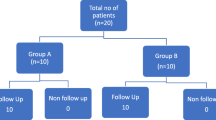Abstract
Purpose
The aim of our study was to compare the effects of fentanyl, remifentanil, and dexmedetomidine on neuromuscular blockade under sevoflurane anesthesia.
Methods
Eighty-four patients were randomized to fentanyl, remifentanil, and dexmedetomidine groups. In the fentanyl group, fentanyl 1.5 μg/kg was given before induction of anesthesia, and additional 50-μg boluses were administered. In the remifentanil group, the initial dose of remifentanil 1 μg/kg was infused in 10 min before induction and 0.1 μg/kg/min infusion was continued during anesthesia. In the dexmedetomidine group, the initial dose of dexmedetomidine 1 μg/kg was infused in 10 min before induction and 1 μg/kg/h infusion was continued during anesthesia. Heart rate, blood pressure, SpO2, EtCO2, and TOF (train-of-four) values of all patients were monitored during anesthesia. Times to reach TOF 0 and TOF 25% and intubation quality were recorded.
Results
T 0 times and quality of intubation were found to be similar among the groups. T 25 time was found to be significantly longer in the dexmedetomidine group than in the fentanyl and remifentanil groups.
Conclusion
Dexmedetomidine infusion increased the duration of neuromuscular blockade with vecuronium during general anesthesia. In addition to analgesic and sedative effects, dexmedetomidine may enhance the duration of neuromuscular blockade and may be used as an adjuvant anesthetic during general anesthesia.
Similar content being viewed by others
References
Talke PO, Caldwell JE, Richardson CA, Kirkegaard-Nielsen H, Stafford M. The effects of dexmedetomidine on neuromuscular blockade in human volunteers. Anesth Analg. 1999;88:633–9.
Weinger MB, Partridge BL, Henry AF. Dexmedetomidine does not modify the neuromuscular blocking action of vecuronium in the anaesthetized rat. Br J Anaesth. 1995;74:455–7.
Viby-Mogensen J, Engbaek J, Eriksson LI, Gramstad L, Jensen E, Jensen FS, Koscielniak-Nielsen Z, Skovgaard LT, Ostergaard D. Good clinical research practice (GCRP) in pharmacodynamic studies of neuromuscular blocking agents. Acta Anaesthesiol Scand. 1996;40:59–74.
Savarese JJ, Caldwell JE, Lien CA, Miller RD. Pharmacology of muscle relaxants and their antagonists. In: Miller RD, editor. Anesthesia. 5th ed. Philadelphia: Churchill Livingstone; 2000. p. 412–90.
Nakahara T, Akazawa T, Kinoshita Y, Nozaki J. The effect of clonidine on the duration of vecuronium-induced neuromuscular blockade in humans. Masui. 1995;44:1458–63.
Takahashi H, Nishikawa T. Oral clonidine does not alter vecuronium neuromuscular blockade in anaesthetized patients. Can J Anaesth. 1995;42:511–5.
Donati F. Onset of action of relaxants. Can J Anaesth. 1988;35:S52–8.
Belleville JP, Ward DS, Bloor BC, Maze M. Effects of IV dexmedetomidine in humans. I. Sedation, ventilation, and metabolic rate. Anesthesiology. 1992;77:1125–33.
Aho M, Lehtinen AM, Erkola O, Kallio A, Korttila K. The effect of IV administered dexmedetomidine on perioperative hemodynamics and isoflurane requirements in patients undergoing abdominal hysterectomy. Anesthesiology. 1991;74:997–1002.
Bloor BC, Ward DS, Belleville JP, Maze M. Effects of IV dexmedetomidine in humans. II. Hemodynamic changes. Anesthesiology. 1992;77:1134–42.
Lawrence CJ, Prinzen FW, de Lange S. The effect of dexmedetomidine on nutrient organ blood flow. Anesth Analg. 1996;83:1160–5.
Weinger MB, Segal IS, Maze M. Dexmedetomidine, acting through central alpha-2 adrenoceptors, prevents opiate-induced muscle rigidity in the rat. Anesthesiology. 1989;71:242–9.
Mantz J, Josserand J, Hamada S. Dexmedetomidine: new insights. Eur J Anaesthesiol. 2011;28:3–6.
Narimatsu E, Niiya T, Kawamata M, Namiki A. Lack in effects of therapeutic concentrations of dexmedetomidine and clonidine on the neuromuscular blocking action of rocuronium in isolated rat diaphragms. Anesth Analg. 2007;104:1116–20.
Musgrave IF, Krautwurst D, Schultz G. Imidazoline binding sites and signal transduction pathways. Clin Exp Pharmacol Physiol. 1996;23:990–4.
Abelson KS, Hoglund AU. The effects of the alpha2-adrenergic receptor agonists clonidine and rilmenidine, and antagonists yohimbine and efaroxan, on the spinal cholinergic receptor system in the rat. Basic Clin Pharmacol Toxicol. 2004;94:153–60.
Author information
Authors and Affiliations
Corresponding author
About this article
Cite this article
Ozcan, A., Ozcan, N., Gulec, H. et al. Comparison of the effects of fentanyl, remifentanil, and dexmedetomidine on neuromuscular blockade. J Anesth 26, 196–199 (2012). https://doi.org/10.1007/s00540-011-1270-9
Received:
Accepted:
Published:
Issue Date:
DOI: https://doi.org/10.1007/s00540-011-1270-9




